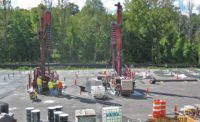In June 2009 National Grid completed a $50 million project to clean up a former manufactured gas plant site polluted with toxic tars and chemicals in Sag Harbor.

Built in 1859, the plant, located in downtown Sag Harbor, operated until 1931. Production ceased after Long Island Gas Corporation purchased the site in 1929 and linked its gas distribution system to the company’s natural gas pipelines.
LILCO subsequently dismantled the plant and gas storage facilities. But by-products of the operation, toxic tars and chemicals, polluted the soils beneath the site.
National Grid, the current owner, and the New York State Department of Conservation reached an agreement on how to remediate the contaminated soil to roughly ten feet below the surface in August 2008.
Remediation strategies and schedules for the site, located in Sag Harbor’s historic downtown business district, were closely coordinated with the local community, according to Shail Pandya, Project Manager at AECOM Environment, New York.
To prevent disruptions during the busy summer tourist season, the original two year construction schedule was shortened to eight months by changing methodologies and working Saturdays.
The project required digging down on average 10-ft. and excavating of 37,000 tons of contaminated soil. With the water table just 6-inches below the surface, tests indicated groundwater pumping rates of two million gallons per day.
In order to cutoff groundwater infiltration into the excavation area, the team installed a soil mix wall composed of Portland cement mixed with native soils. Resulting dewatering flow rates averaged less than 300,000 gallons per day. The water was treated onsite.
The wall also acted as a shoring technology, reduced vibration and noise to the community and helped expedite the job.
The team installed a 3,900-ft. long submerged pipeline to discharge the treated water 3,700-ft into the harbor, beyond the tidal stagnation point. This strategy addressed community concerns that discharging large volumes of fresh water into the bay would affect water salinity and damage the bay. More than 15 million gallons of water were pumped into the bay.
A temporary 100-ft by 200-ft by 50-ft high fabric tent was erected over the excavation area to prevent odors leaving the site. Six air monitoring stations were employed to ensure protection of the community.
The excavation was backfilled with over 31,700 tons of soil and 4,700 tons of gravel. In total 4,450 trucks went into and out of the project carting contaminated soils and backfill.
Weather challenges included flooding, heavy snows and high winds. “We had one of the worst winters in years,” Pandya says. During one storm high winds tore down portions of the tent, requiring the team to reassemble the structure.
Key Players
Developer/Owner: National Grid, Hicksville, N.Y.
Project Management & Design, Civil and Environmental Engineering, Environmental Controls & Monitoring: AECOM Environment, New York
General Contractor: Sevenson Environmental, Niagara Falls, N.Y.
Engineering and Construction Support: GEI Consultants, Inc., Montclair, N.J.
Soil Mix Wall Subcontractor: Geo-Con/Environmental Barrier, Monroeville, Penn.
Dewatering Contractor: Griffin Dewatering New England Inc., Hillside, N.J.
Marine Pipeline Contractor: Miller Environmental Group, Calverton, N.Y.


